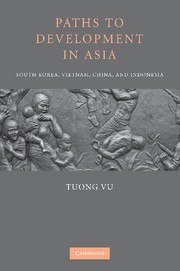Book contents
- Frontmatter
- Contents
- List of Tables and Figure
- Acknowledgments
- List of Abbreviations
- 1 State Formation Dynamics and Developmental Outcomes
- PART ONE DIVERGENT NATIONAL PATHS OF STATE DEVELOPMENT
- 2 South Korea: Confrontation and the Formation of a Cohesive State
- 3 Indonesia: From Accommodation to Confrontation
- 4 Rival State Formations in China: The Republican and Maoist States
- 5 Vietnam: Accommodation and Arrested Revolution
- PART TWO VARIANTS OF ACCOMMODATION: VIETNAM AND INDONESIA COMPARED
- References
- Index
5 - Vietnam: Accommodation and Arrested Revolution
Published online by Cambridge University Press: 04 August 2010
- Frontmatter
- Contents
- List of Tables and Figure
- Acknowledgments
- List of Abbreviations
- 1 State Formation Dynamics and Developmental Outcomes
- PART ONE DIVERGENT NATIONAL PATHS OF STATE DEVELOPMENT
- 2 South Korea: Confrontation and the Formation of a Cohesive State
- 3 Indonesia: From Accommodation to Confrontation
- 4 Rival State Formations in China: The Republican and Maoist States
- 5 Vietnam: Accommodation and Arrested Revolution
- PART TWO VARIANTS OF ACCOMMODATION: VIETNAM AND INDONESIA COMPARED
- References
- Index
Summary
VIETNAM AND CHINA IN CONTRAST
Unlike South Korea and Indonesia, which lie far apart geographically, China and Vietnam share a border, and their development paths were not always separate for both ideological and geopolitical reasons. From the 1920s through the early 1960s, the Soviet Union was a source of ideological inspiration as well as practical assistance and doctrinal guidance for both Chinese and Vietnamese communists, who studied Lenin and Stalin in translation, toured Soviet modern factories and collective farms built under Stalin, and received training from Soviet advisers in revolution and administration.
The Vietnamese also received extensive policy guidance in the 1950s from their Chinese comrades, who were more experienced in revolution and state making. Chinese experiences were useful to Vietnam because the historical contexts facing both revolutions were fundamentally similar: both sought to build socialism in predominantly rural, backward countries under the constant threat of “imperialist” attacks. “Land reform” was a particular area where Vietnam learned much from China. The Soviet Union never implemented any land redistribution; Chinese communists developed their own expertise on the issue, and their Vietnamese comrades benefited from consulting China's policies and working with Chinese advisers in Vietnam.
Despite similar conditions and so much shared knowledge among their leaders, several indicators show a striking contrast in the character of socialist development between the two countries. China's average annual economic growth rate between 1953 and 1978 was 6 percent (Lin et al. 1996, 71).
- Type
- Chapter
- Information
- Paths to Development in AsiaSouth Korea, Vietnam, China, and Indonesia, pp. 100 - 128Publisher: Cambridge University PressPrint publication year: 2010



